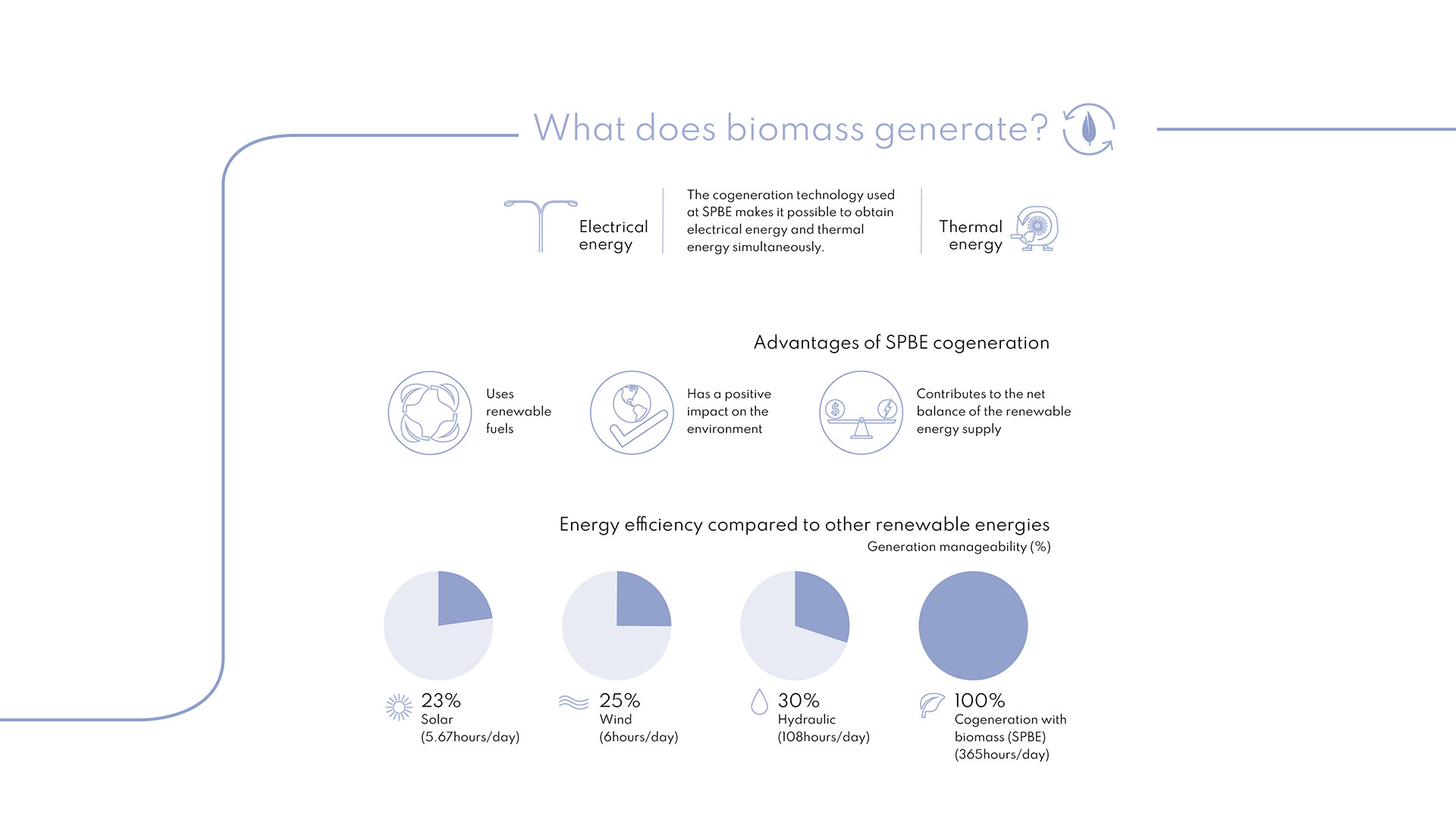The main source of manageable and sustainable energy in the Dominican Republic
San Pedro Bio Energy
We are the first renewable energy plant with biomass-based generation technology in the Dominican Republic. Our plant, which has been declared first of its kind by the National Council for Climate Change and Clean Development Mechanism, began operating in June 2017 and is located in the province of San Pedro de Macorís. As a sustainable and socially committed company, SPBE complies with the standards of the United Nations Global Compact. For this reason, its operations are aimed at significantly reducing carbon dioxide emissions, promoting the Sustainable Development Goals (SDGs) and implementing environmentally friendly processes.
The cogeneration technology used at SPBE makes it possible to obtain electrical and thermal energy simultaneously. This procedure stands out for its efficiency, given that from a single primary energy consumption process (biomass from sugarcane bagasse and wood chips), the plant produces two types of energy, which it then injects into the CAEI Sugar Factory and distributes to the National Interconnected Electrical System (SENI for its Spanish acronym), as well as to a large industrial company in the country. In this first stage of the project, SPBE’s cogeneration unit has a 30.5-megawatt turbine, a high-efficiency boiler and a production cycle of 335 days per year and 30 days corresponding to its annual maintenance shutdown.
To ensure the responsible use and management of natural resources, the SPBE plant was designed in accordance with the World Bank and International Finance Cooperation’s (IFC) environmental, health and safety regulations for power plants. In addition, its construction was carried out under the incentives of Law 57-07 for the Development of Renewable Energy Sources and their Special Regimes in the Dominican Republic. Accordingly, the plant meets and exceeds national and international standards related to atmospheric emissions, water consumption, energy efficiency, and noise.
SPBE provides strong power and nearly 200 GWh of net renewable energy to the Dominican Republic’s electricity grid. With this production, the company avoids the emission of 90 thousand tons of CO2 each year. Currently, in order to distribute a greater amount of clean energy in the future, we are developing a strategic plan based on the optimization of biomass sources (wood chips and sugarcane bagasse), operational efficiency, and sustained investment in boiler technologies. At SPBE we work for a country and a world that helps the environment, within a regulatory framework that respects human rights and sustainability.
Corporate philosophy
Mission
To be a leader in the cogeneration of clean energy in order to contribute to the development of a more competitive and sustainable national energy industry.
Vision
Commitment to continuous improvement for the development of the internal team, the community, and the country through the implementation of improved generation technologies.
Values
Respect: towards our employees, customers, the operating environment, and our corporate mission.
Honesty: generate qualities that foster a sense of social ethics, commitment to our vision, and personal integrity in the company’s team.
Teamwork: foster a culture of collaboration to communicate openly with respect and improve the quality of our decisions.
Organizational Chart
A unique, efficient, and Dominican plant
The boiler’s high efficiency and its installed turbine capacity make SPBE the only generator of its kind in the country, but also one of the main sources of manageable and sustainable energy for Dominicans. Since the beginning of our operations in the special regime, we have been distributing renewable energies through the regulated market (SENI) and to customers in the unregulated users’ market. Thanks to our offer, the participation of clean energy has increased significantly in the Dominican Republic’s energy matrix.
In operating terms, the cogeneration process represents a savings in fuel costs of 667 million pesos, or 78% less compared to a conventional fossil fuel plant. These plants require an investment of 850 million pesos in raw materials, while sugarcane bagasse for the cogeneration plants represents a cost of 183 million pesos.
The start-up of SPBE enabled CAEI’s Sugar Factory, one of our main customers, to increase its production capacity by 23%, from 6,500 to 8,000 tons of milled sugarcane per day. This increase in milling represented an increase in sugar production, so that the factory, along with other sugar producers in the country, guaranteed local supplies and reduced the need for imports. It should also be noted that the generation of energy from biomass made it possible to manage the 311,275 tons of sugarcane bagasse produced by this factory.
SPBE’s cogeneration process has a positive impact on the environment and, therefore, protects and respects the natural resources of the province of San Pedro de Macorís. Finally, it is important to highlight the capacity that cogeneration has compared to other renewable source generation systems. According to the November 2017 Renewable Energy Report, electricity generation by water, sun and wind is between 23% and 40% capacity, while the power management capacity in a biomass plant such as SPBE is 100%. In other words, it is available 24 hours a day, 365 days a year.





